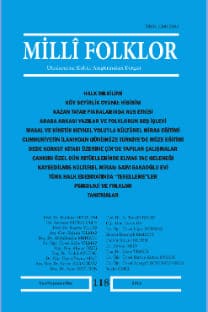The lost ring: World heritage and intangible cultural heritage
Miras konusu, son zamanlarda bir çok konuyla birlikte akademik bir tartışma alanı haline gelmiştir. İnsan kültürlerinin tamamlayıcı bir parçası olan miras, günümüzde hem yetkilileri ve araştırmacıları hem de halkı, uluslararası organizasyonları ilgilendirir. UNESCO önceleri bütün potansiyelini, benzer bir alana, son yarım yüzyıl boyunca gelişme gösteren, mirasın çeşitli alanlarını kapsayan kural oluşturan bir cepheye taşımıştır. Bu alanlar birbiriyle öylesine yakından ilişkilidir ki standart belirleyici araçlar kaçınılmaz bir biçimde birbiriyle örtüşür. Sırasıyla 1972 ve 2003 sözleşmeleri aracılığıyla kapsanan Dünya Mirası ve Somut Olmayan Kültürel Miras’ta olduğu gibi. Bu makale, bu iki sözleşme arasında olan ya da olmayan bağları tartışmayı hedeflemektedir. Öncelikle Dünya Mirası Listesi’ndeki somut olmayan kültürel miras unsurlarını da içeren sit alanlarının bir sayımı yapılacak ve ikisi arasındaki bağın doğası incelenecektir. Son olarak iki standart belirleyici araç arasındaki işbirliği biçimlerinin neler olabileceği ortaya konulacaktır.
Kayıp halka: UNESCO dünya mirası ve somut olmayan kültürel miras
Heritage has become lately a scholarship field with multiple issues. An integral part of human cultures, heritage interests today both the decision maker, the researcher, the public but also the international organizations. UNESCO early felt all the potential of such a field, developing during the last half century, a normative arsenal covering various domains of heritage. These domains are so close that the standard-setting instruments inevitably overlap each other. This is the case of the World heritage and of the Intangible cultural heritage, respectively covered by the 1972 Convention and the 2003 Convention. This paper will consider the links that exist or not between these two conventions. It will try to make a first census of the World heritage List sites where elements of the Intangible cultural heritage Representative List exist and briefly examine the nature of the link between them. It will, finally, consider what can be the modalities of cooperation between the two standard-setting instruments.
___
- Aïkawa-Faure, Noriko, « Panorama historique de la préparation de la Convention internationale pour la sauvegarde du patrimoine culturel immatériel de l’UNESCO » in UNESCO, Intangible Heritage, n°spécial, Museum International, n° 221-222, Paris, 2004.
- Aïkawa-Faure, Noriko, “From the proclamation of Masterpieces to the Convention of Safeguarding of Intangible Cultural Heritage”, Laurajane Smith & Natsuko Akagawa, eds., Intangible Heritage, London, Routledge, 2008: 13-44.
- Bedjaoui, Mohammed, « La Convention portant sauvegarde du patrimoine culturel immatériel: un cadre juridique et des principes universellement connus » in UNESCO, Intangible Heritage, n°spécial, Museum International, n° 221-222, Paris, 2004.
- Blake, Janet, “UNESCO’s 2003 Convention of Safeguarding of Intangible Cultural Heritage : the implications of community involvement”, Laurajane Smith & Natsuko Akagawa, eds., Intangible Heritage, London, Routledge, 2008: 45-73.
- Blake, Janet, Elaboration d’un nouvel instrument normatif pour la sauvegarde du patrimoine culturel immatériel. Eléments de réflexion, Paris, Publications de l’UNESCO, édition révisée, 2002.
- Bourdieu, Pierre, Méditations pascaliennes, Paris, Seuil, 1997.
- Buppha Devi, S.A.R. la princesse Norodom, ‘Le festival Ramayana, patrimoine immatériel d’Angkor’, Museum International, n°213-214, Spécial Angkor, Paris, Editions de l’UNESCO, 2002.
- Cleere, Henry, “The uneasy bedfellows: universality and cultural heritage”, in R. Layton, G. Stone and J. Thomas, eds., Destruction and Conservation of Cultural Property, London, Routledge, 2001.
- Comité du patrimoine mondial, Orientations devant guider la mise en śuvre de la Convention du patrimoine mondial, UNESCO, version de février 2008.
- Hafstein, Valdimar Tr., “Intangible Heritage as a List: From masterpieces to representation”, Laurajane Smith & Natsuko Akagawa, eds., Intangible Heritage, London, Routledge, 2008: 93-111.
- Hobsbawm, Eric J. et Terence Ranger, éd., L’Invention de la Tradition, tr. fr. (original publié en 1983), Paris, éd. Amsterdam, 2006.
- Skounti, A., “The Authentic Illusion. The intangible Cultural Heritage of Humanity. The Moroccan Experience”, in Laurajane Smith & Natsuko Akagawa, eds., Intangible Heritage, London, Routledge, 2008: 74-92.
- Skounti, Ahmed & Ouidad Tebbaa, La Place Jemaâ El Fna, patrimoine culturel immatériel de Marrakech, du Maroc et de l’humanité, Rabat, Bureau de l’UNESCO, 2006.
- Smith, Laurajane & Natsuko Akagawa, eds., Intangible Heritage, London, Routledge, 2008.
- Sullivan, S., “Local involvement and traditional practices in the World Heritage”, in E. de Merode, R. Smeets and C. Westrik, eds., Linking Universal and Local Values: Managing a Sustainable Future for World Heritage, Paris: World Heritage Centre, 2004: 49-55.
- UNESCO, Convention concernant la protection du patrimoine mondial, culturel et naturel, 1972.
- UNESCO, Convention pour la sauvegarde du patrimoine culturel immatériel, 2003.
- Van Hoof, Herman, eds., Le patrimoine culturel des Caraïbes et la Convention du patrimoine mondial. The Cultural Heritage of the Caribbean and the World Heritage Convention, Paris, Editions du Comité des Travaux historiques et scientifiques, 2006, p. 30.
- ISSN: 1300-3984
- Yayın Aralığı: Yılda 4 Sayı
- Başlangıç: 1989
- Yayıncı: Geleneksel Yayıncılık Eğitim San. Tic. Ltd. Şti.
Sayıdaki Diğer Makaleler
Turistik ticari halkbilimsel ürünler ve Beypazarı
The lost ring: World heritage and intangible cultural heritage
Bir halk sanatı örneği:1879-80 (1297 H.) tarihli Edirnekari ahşap sandık
Ortak kültürlerden ortak tatlar: Kosova mutfağı
Evliya Çelebi'ye göre Acem manisi
Van halk masal ve hikayelerinin icra bağlamı olarak Divanhane ( Duvakhane) geleneği
Bebekleri dünyaya leyleklerin getirdiğine dair inancın Türk mitolojisindeki kökleri üzerine
Hatay'ın Altınözü ilçesi Babatorun köyü'ndeki Zılgıtlar üzerine bir araştırma
Alevilik-Bektaşi geleneğinde muhabbet: Ruhsal bir bilgi ortamı
Osmanlı sarayı'nda cirit alayları: Lahanacılar ve Bamyacılar
